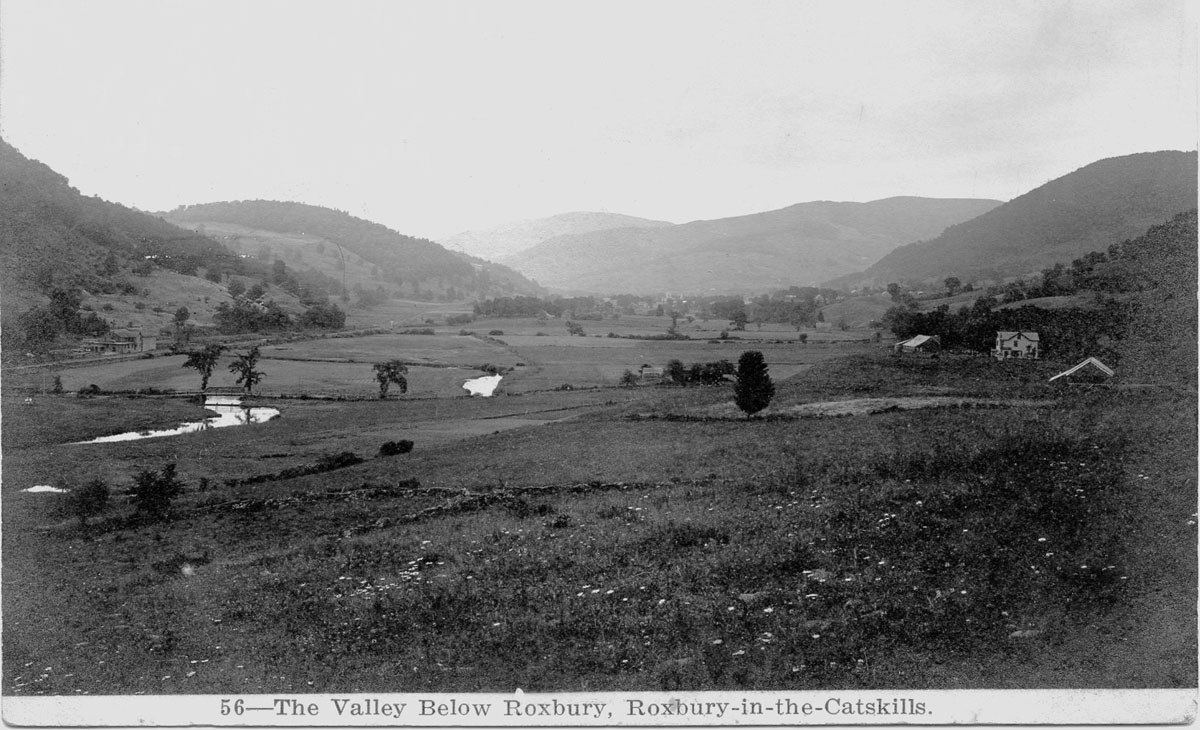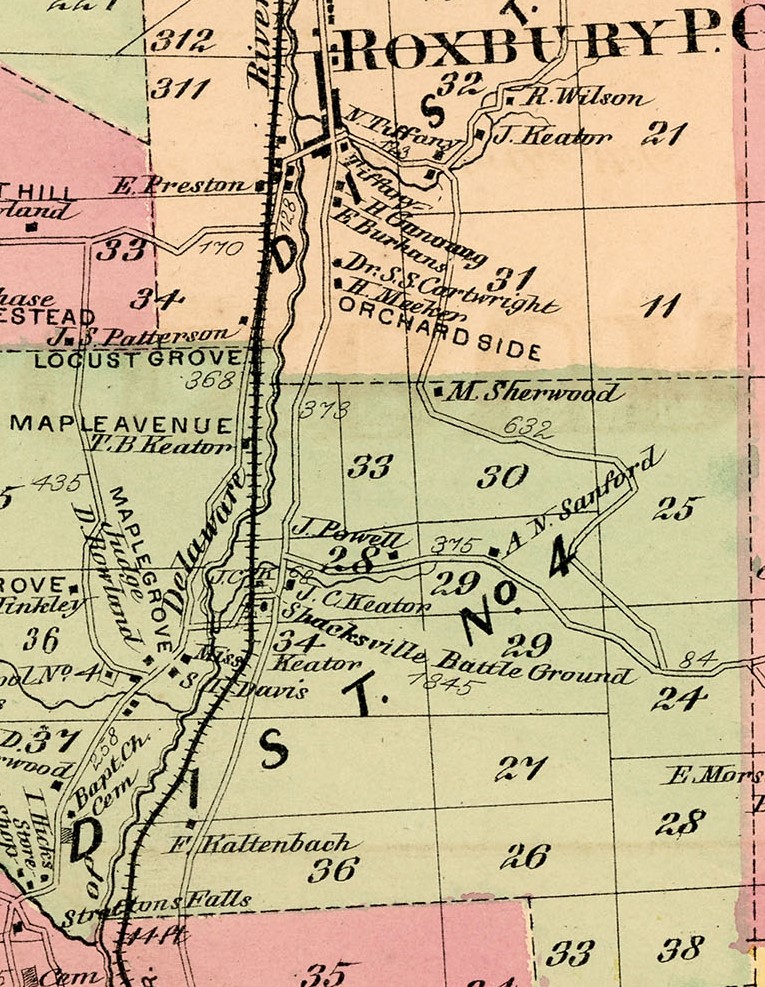
This is the general area where the Battle of Shacksville is presumed to have happened. That’s the East Branch of the Delaware River at center left crossing under the bridge on what is now Briggs Road. Town of Roxbury collection
The Battle of Shacksville,
March 14, 1845
A little-known chapter of the Anti-Rent War which convulsed the Catskills in the mid-1840s took place near the community known as Shacksville just south of Roxbury off what is now NYS Route 30. Central to the dramatic episode was Daniel W. Squire, a farmer who, as a leader of the rebellious “Calico Indians,” had provoked the ire of the Delaware County Sheriff and his deputies.
Squire’s mother Nabby in 1830 had paid $750 for a 76-acre farm just north of the present Darling farm on Route 30. The deed, which in 1837 was conveyed by Nabby to son Daniel, carried from owner to owner the requirement that an annual rent of one shilling per acre be paid (though to whom is not clear).
Many local farmers had withheld their rent in protest of the system that allowed wealthy, distant patent holders to require annual payments of crops, labor or cash for land which they were prevented from owning, or which they had purchased but was still subject to rent. They disguised themselves in sheepskin masks and calico dresses (“Calico Indians”) and vowed to defend fellow farmers who were visited by deputies and Up-Rent posses demanding payment.
Daniel W. Squire, a farmer and sawmill operator, was a respected leader known as “Big Thunder.” His wife Phebe allegedly sewed costumes for other “Indians,” who came to his defense in September 1844 when his neighbor, landlord agent Timothy Corbin, and Sheriff Green Moore attempted to serve a warrant on Squire for nonpayment of rent. Tin horns alerted the calico tribe and they descended en masse, seizing and burning the papers, mounting Corbin on a soap box and applying hot tar and feathers as punishment.
In February of 1845, still itching to arrest Squire, Undersheriff Osman Steele led a surprise raid on his home. With little time to escape, Squire reportedly hid between feather ticks on a bed on which his wife Phebe, and Nabby, the widowed mother who lived with them, were lying. Discovered, he was carted off to jail in Delhi, charged with riot and assault and battery. He was later released on bail.
A series of nasty confrontations between Up and Down Renters throughout the area over the next few months elevated tensions leading to the conflict near Shacksville, a cluster of buildings at the intersection of Green Road and Stratton Falls Road. On March 11, 1845, Undersheriff Steele led a posse of 80 men, who captured another rebel farmer, Zera Preston, and placed him under guard at the store of Edward Burhans in Beaverdam (the hamlet of Roxbury). Daniel Squire called together his compatriots who spent the night at his house before heading out to rescue Preston. They encountered Steele and company and a violent clash followed.
Although the exact location of the skirmish is uncertain, at least some of the fighting is believed to have taken place in the area of today’s Briggs Road which connects Route 30 to Statton Falls Road in the vicinity of Shacksville. Participants described in later court testimony close combat with musket balls fired by rebels crouched behind a stone wall. Several of the “Indians” were unmasked by their opponents. One of them was Silas Tompkins, constable and collector from Middletown. Eleven men and a teenage boy were arrested, shackled and placed in the back of a wagon for transport through the cold dark night to the Delhi jail.
The “Battle of Shacksville” was over, but the war continued towards the culminating event, the killing of Osman Steele in Andes that spring. Though he was nowhere near the scene, Squire was among 94 people indicted for various charges related to the murder on the Moses Earl farm. He was sentenced to life in prison for being an accessory to the fact, and, with three comrades, spent two years in Clinton prison before they were pardoned in 1847. Daniel’s mother, Abigail Squire, made the difficult 300-mile trip to the Adirondacks to visit the prisoners in the summer of 1846 when she was 60 years old. She reported to the worried families of the men that they were in good health and good spirits.

The 1869 Beers Atlas map of the Town of Roxbury shows the location of the “Shacksville Battle Ground 1845” nearly a quarter century after the Anti-Rent War clash between disgruntled farmers and the county sheriff and his posse. A dotted line extends to lands of Jacob C. Keator (JKC) where today’s Briggs Road connects the north-south Route 30 with Stratton Falls Road.
In 1846 and ’47, the feudal system of land ownership in the Catskills was ended through political action and legislation. Many farmers found the means to then purchase their hard-won land. But Daniel W. Squire, who had been away for two years, lost his 76-acre farm when the mortgage was foreclosed. His wife Phebe died in 1852 and was buried in the Old School Baptist Church Cemetery next to two daughters who had died in 1841 and 1842.
Daniel found another wife, Mary Rogers, and moved with her, four surviving children and his mother to Windsor, Broome County. They had two more children, and in 1857 he was named postmaster of New Ohio in the neighboring town of Colesville.
The reverberations of the Anti-Rent War having been long quieted, “Big Thunder” passed away in 1881 and is buried in Riverside Cemetery, Windsor.
For the colorful details of this compelling era in State and local history, consult Tin Horns and Calico by Henry Christman (1978, Hope Farm Press); and A Free Soil, A Free People: The Anti-Rent War in Delaware County. New York by Dorothy Kubik (1997, Purple Mountain Press). Other sources consulted for this article were FamilySearch.org; FindAGrave.com; Ancestry.com; and nyshistoricnewspapers.com.
